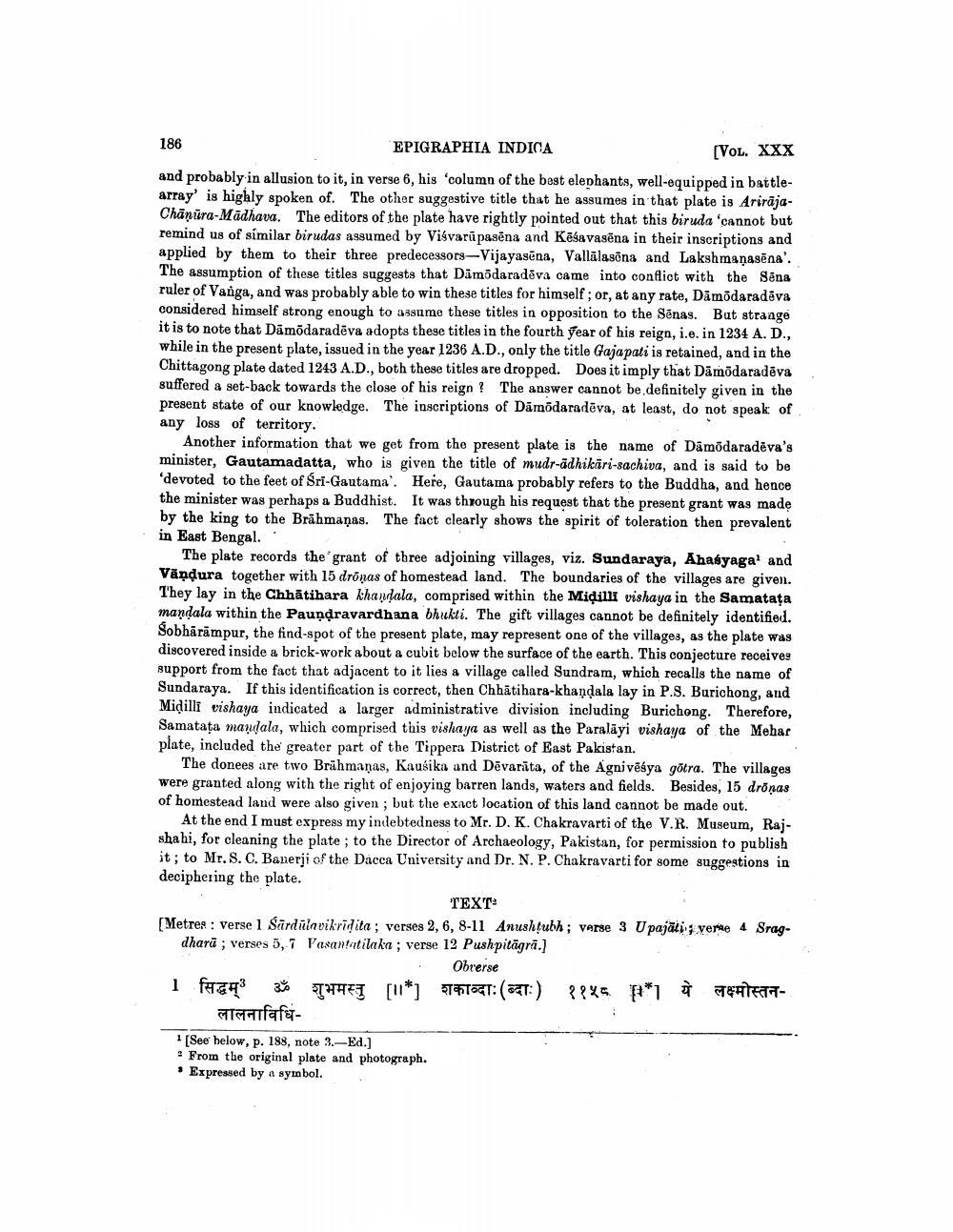________________
186 EPIGRAPHIA INDICA
[Vol. XXX and probably in allusion to it, in verse 6, his 'column of the best elephants, well-equipped in battlearray' is highly spoken of. The other suggestive title that he assumes in that plate is ArirājaChāņura-Madhava. The editors of the plate have rightly pointed out that this biruda 'cannot but remind us of similar birudas assumed by Visvarūpasēna and Kēsavasēna in their inscriptions and applied by them to their three predecessors-Vijayasina, Vallalasõna and Lakshmanasena'. The assumption of these titles suggests that Damodaradeva came into conflict with the Sena ruler of Vanga, and was probably able to win these titles for himself; or, at any rate, Dāmõdaradeva considered himself strong enough to assume these titles in opposition to the Senas. Bat strange it is to note that Damodaradēva adopts these titles in the fourth year of his reign, i.e. in 1234 A.D., while in the present plate, issued in the year 1236 A.D., only the title Gajapati is retained, and in the Chittagong plate dated 1243 A.D., both these titles are dropped. Does it imply that Damodaradova suffered a set-back towards the close of his reign? The answer cannot be definitely given in the present state of our knowledge. The inscriptions of Damodaradēva, at least, do not speak of any loss of territory.
Another information that we get from the present plate is the name of Damodaradēva's minister, Gautamadatta, who is given the title of mudr-adhikari-sachiva, and is said to be 'devoted to the feet of Sri-Gautama'. Here, Gautama probably refers to the Buddha, and hence the minister was perhaps a Buddhist. It was through his request that the present grant was made by the king to the Brāhmaṇas. The fact clearly shows the spirit of toleration then prevalent in East Bengal.
The plate records the grant of three adjoining villages, viz. Sundaraya, Ahasyagal and Vāņdura together with 15 drõņas of homestead land. The boundaries of the villages are given. They lay in the Chhātihara khanala, comprised within the Midilli vishaya in the Samatata mandala within the Paundravardhana bhukti. The gift villages cannot be definitely identified. Sobhārāmpur, the find-spot of the present plate, may represent one of the villages, as the plate was discovered inside a brick-work about a cubit below the surface of the earth. This conjecture receive support from the fact that adjacent to it lies a village called Sundram, which recalls the name of Sundaraya. If this identification is correct, then Chhātihara-khandala lay in P.S. Burichong, and Midilli vishaya indicated a larger administrative division including Burichong. Therefore, Samatata mandala, which comprised this vishaya as well as the Paralāyi vishaya of the Mehar plate, included the greater part of the Tippera District of East Pakistan.
The donees are two Brāhmaṇas, Kausika and Dēvarata, of the Agnivēśya götra. The villages were granted along with the right of enjoying barren lands, waters and fields. Besides, 15 dronas of homestead land were also given ; but the exact location of this land cannot be made out.
At the end I must express my indebtedness to Mr. D. K. Chakravarti of the V.R. Museum, Rajshahi, for cleaning the plate ; to the Director of Archaeology, Pakistan, for permission to publish it ; to Mr. S.C. Banerji of the Dacca University and Dr. N. P. Chakravarti for some suggestions in deciphering the plate.
TEXT [Metres : Verse 1 Sürdülnvikridita; verses 2, 6, 8-11 Anushtubh ; verse 3 Upajāli, verse 4 Sragdharū ; verses 5, 7 Vasantatilaka ; verse 12 Pushpitägra.)
Obrerse i fa 3 TH+FT [11*) 791041: (247:) 8845 #*1 À TEHTETA
ataifafa
1 [See below, p. 188, note 3.-Ed.) . From the original plate and photograph. • Expressed by a symbol.




